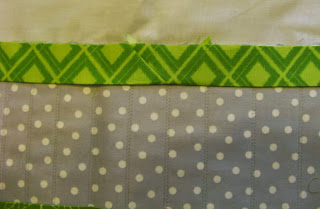Use 1/4” seam
allowance for all seams.
The photos in this
tutorial come from my Craftsy sewing pattern, “Trifold Crochet Hook Case”.
Note: When binding
smaller projects like mug rugs and this crochet case, I always starch the
fabrics before cutting. Fabrics that are stiffly starched will press firmly in
place. This will make a huge difference when the time comes to press the
mitered corners of the binding into a perfect 45-degree angle. Corners will
keep their shape beautifully with minimal pinning when you do the final stitching
on the front of the quilt.
1. Measure the distance around the
item you will be binding. Add 6 inches to this measurement to find the length
of the piece of binding you will need. (It's always better to be generous in cutting rather than skimpy.)
2. Cut strips of binding fabric 2 1/4” wide. If you need
only a single strip, add 6 inches to the needed length. If you need more than
one strip you will need to add the extra 6 inches when your strips are sewn
together.
3. Cut the ends at a 45-degree angle. There are several ways to do this, but I
usually use a rotary cutting ruler with a 45-degree angle on one end.
4. Sew the strips right sides together as shown in the photo.
Press open. Measure to make sure that you have the extra six inches in length.
5. Fold the length of binding in half and press. It will now
measure 1 1/8 inches in width.
Note: you will be
stitching the binding to the back of your quilt.
6. Place a pin to hold in the binding in place at the center
of one side. Lay the binding along the back of your quilt. The raw edge of the
binding should be against the raw edge of the quilt with the folded edge
pointing inward.
7. Allow six inches of unattached binding before beginning
to sew. Backstitch a few stitches, then stitch to within 1/4” of the corner.
9. Lift the presser foot and turn toward the corner. Stitch
diagonally right through the edge of the corner. Remove the quilt and snip the
threads.
11. Stitch down the next side to within 1/4” of the corner and
repeat steps 9 and 10.
12. Continue stitching the binding to the edges of the quilt
and mitering the corner turns until you are within 6 inches of the pin holding
the other end of the binding in place. Backstitch, remove quilt from the machine and
snip threads.
13. Place the two loose ends of the binding together. Use a pin to mark exactly 1/4” back from the
cut edge on the fold of the first section of the binding. Lay the end of the
other section of binding right on top of, or tucked right under, the first
piece. Make sure the binding lies smoothly along the edge of the quilt.
14. Put a pin through the fold of this end in exactly in the
same place as the first pin. This pin will serve as a cutting guide.
15. Open this end of
the binding and lay it right side up on a cutting mat. Carefully measure 1/4”
out from the pin toward the uncut end of the binding. You will be adding
1/4” to the binding before cutting it.
16. Cut at a 45-degree angle that matches the angle of the
original cut.
17. Place the two ends of the binding right sides together
and stitch 1/4 inch from the edge just as you did when attaching strips of
binding to each other.
18. Press the seam open. Refold and press the binding. Lay
it in place along the quilt edge and stitch in place. Snip threads.
19. Turn the quilt over to the back. Press the straight seams flat. Don’t press
the corners from this side.
20. Turn to the front. Fold the binding in and press all
along the sides. At the corner, continue pressing along the same fold.
21. Turn the quilt a quarter turn. Beginning at the corner
you just worked on, fold this side over and press. Continue until all sides are
pressed in place. Pin.
22. Stitch close to the edge of the binding all around the
quilt.
 |
| Front and Back Views |
That’s it!














No comments:
Post a Comment